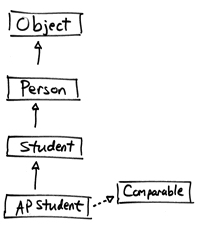Student studentJane= new Student();
studentJane.myAge = 15; // error since myAge is private in the Person class
studentJane.setAge(15);
studentJane.haveBirthday(); // myAge is now 16
System.out.println(studentJane.getAge()); // displays 16
Person personBob = new Person();
Student studentJane = new Student();
personBob.saySomething(); // displays "I am a person"
studentJane.saySomething(); // displays "I am a student"
public class CheckingAccount extends BankAccount
or
public class BoxBug extends Bug
If a class implements one or more interfaces and extends a parent class, you use syntax like this where the keyword extends must be before the keyword implements:
public class BoxBug extends Bug implements Comparable, Movable

A solid line with a hollow arrowhead is drawn from a child class to the parent class that it extends.This indicates an "is-a" relationship.
A dotted line with a hollow arrowhead is used to point from a class to an interface that it implements.
Classes in the same level of a hierarchy chart are called sibling classes.
A UML (Unified Modeling Language) diagram goes even further than a class hierarchy chart in illustrating the inheritance relationships between classes. We will not formally study UML diagrams this year, but in a college programming course you would probably need to use them.
public interface Movable extends Locatable
In fact, an interface can extend multiple interfaces as in
public interface Movable extends Locatable, Comparable
Questions related to this are rarely asked on the AP exam by the way.